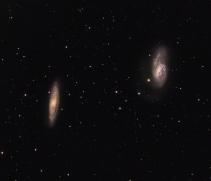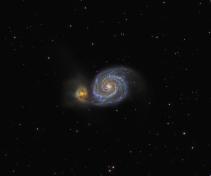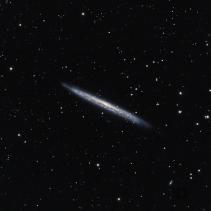Galaxies
M 65 - M 66
Messier 65 (also known as NGC 3623) is an intermediate spiral galaxy about 35 million light-years away in the constellation Leo. It was discovered by Charles Messier in 1780. M65, M66, and NGC 3628 comprise the famous Leo Triplet, a small group of galaxies.
M65 was discovered by Charles Messier and included in his Messier Objects list. However, William Henry Smyth accidentally attributed the discovery to Pierre Méchain in his popular 19th century astronomical work A Cycle of Celestial Objects (stating "They [M65 and M66] were pointed out by Méchain to Messier in 1780"). This error was in turn picked up by Kenneth Glyn Jones in Messier's Nebulae and Star Clusters. This has since ramified into a number of other books by a variety of authors.
Messier 66 (also known as NGC 3627) is an intermediate spiral galaxy about 36 million light-years away in the constellation Leo. It was discovered by Charles Messier in 1780. M66 is about 95 thousand light-years across with striking dust lanes and bright star clusters along sweeping spiral arms. As of 2015, four supernovae have been observed in M66.
M 51
The Whirlpool Galaxy, also known as Messier 51a, M51a, or NGC 5194, is an interacting grand-design spiral galaxy with a Seyfert 2 active galactic nucleus in the constellation Canes Venatici. It was the first galaxy to be classified as a spiral galaxy. Recently it was estimated to be 23 ± 4 million light-years from the Milky Way, but different methods yield distances between 15 and 35 million light-years. Messier 51 is one of the best known galaxies in the sky. The galaxy and its companion, NGC 5195, are easily observed by amateur astronomers, and the two galaxies may even be seen with binoculars. The Whirlpool Galaxy is also a popular target for professional astronomers, who study it to further understand galaxy structure (particularly structure associated with the spiral arms) and galaxy interactions.
What later became known as the Whirlpool Galaxy was discovered on October 13, 1773, by Charles Messier while hunting for objects that could confuse comet hunters, and was designated in Messier's catalogue as M51. Its companion galaxy, NGC 5195, was discovered in 1781 by Pierre Méchain, although it was not known whether it was interacting or merely another galaxy passing at a distance. It was, however, not until 1845 that William Parsons, 3rd Earl of Rosse, employing a 72-inch (1.8 m) reflecting telescope at Birr Castle, Ireland, found the Whirlpool possessed a spiral structure, the first "nebula" to be known to have one. These "spiral nebulae" were not recognized as galaxies until Edwin Hubble was able to observe Cepheid variables in some of these spiral nebulae, which provided evidence that they were so far away that they must be entirely separate galaxies.
M 106
Messier 106 (also known as NGC 4258) is an intermediate spiral galaxy in the constellation Canes Venatici. It was discovered by Pierre Méchain in 1781. M106 is at a distance of about 22 to 25 million light-years away from Earth.
It is also a Seyfert II galaxy. Due to x-rays and unusual emission lines detected, it is suspected that part of the galaxy is falling into a supermassive black hole in the center. NGC 4217 is a possible companion galaxy of Messier 106. A Type II supernova was observed in this galaxy in May 2014.
NGC 5907
NGC 5907 is a spiral galaxy located approximately 50 million light years from Earth. It has an anomalously low metallicity and few detectable giant stars, being apparently composed almost entirely of dwarf stars. It is a member of the NGC 5866 Group.
NGC 5907 has long been considered a prototypical example of a warped spiral in relative isolation. Then in 2006, an international team of astronomers announced the presence of an extended tidal stream surrounding the galaxy that challenges this picture and suggests the gravitational perturbations induced by the stream progenitor may be the cause for the warp.
NGC 5907 is also known as the Knife Edge or Splinter galaxy.
The galaxy was discovered in 1788 by William Herschel. Supernova 1940A was in this galaxy.




